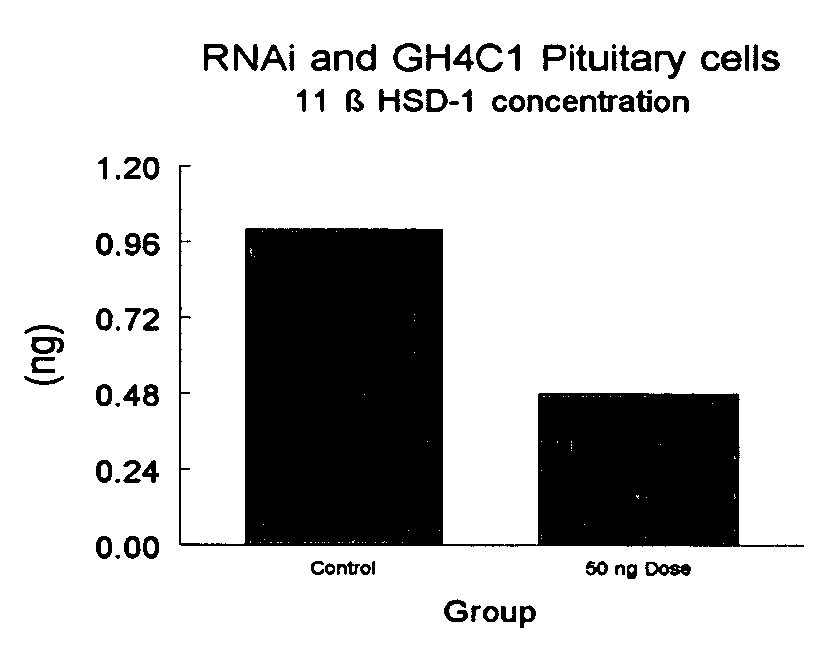RNA interference mediated inhibition of 11beta hydroxysteriod dehydrogenase-1 (11beta HSD-1) gene expression
a technology of hydroxysteriod dehydrogenase and rna interference, which is applied in the direction of enzymology, biochemistry apparatus and processes, and genetic material ingredients, can solve the problems of impaired stress responsivity, exaggerated acth and cort response, etc., and achieves the effect of efficient and quick liver uptake of injected rna
- Summary
- Abstract
- Description
- Claims
- Application Information
AI Technical Summary
Benefits of technology
Problems solved by technology
Method used
Image
Examples
example 1
11β HSD-1 Plays a Role in Obesity that is not Genetically Induced
[0039] The Inventors have generated evidence that supports the hypothesis that access to a high fat diet promotes increased 11β HSD-1 message and activity. Two complementary approaches have been used to generate convincing evidence that the high fat diet will in fact induce increased enzyme message. These observations, coupled with recent findings that 11β HSD-1 is elevated in genetically obese rats and in obese humans, suggests that this enzyme plays an important role in several forms of obesity including forms of obesity that are not genetically induced.
Quantitative RT-PCR
[0040] Liver samples from 3 rats fed either the high fat diet for 10 weeks, or their standard diet controls were used. Total liver RNA was isolated using Tri-Reagent. DNA contamination was removed, followed by cDNA synthesis. 11β HSD-1 and GAPDH expression levels were then analyzed in separate real time PCR reactions. A melt curve analysis was p...
example 2
dsRNA Synthesis
Template Preparation
[0044] RNA is extracted from the liver of an adult male Wistar rat using Tri-Reagent according to directions provided by the manufacturer. Briefly, 1 mL of TriReagent is added to a homogenization tube to which 100 mg of frozen liver is added. The sample is homogenized for 30 seconds. The sample is then allowed to come to room temperature for 10 minutes after which 100 μL BCP is added and shaken vigorously for 15 seconds. The sample is then allowed to incubate at room temperature for 5 minutes. It is then centrifuged at 12000 g for 15 minutes at 4° C. The aqueous phase (600 μL) is transferred to RNAse-free 2.0 ml microtubes. One mL of TriReagent is added and vortexed. An additional 100 μL BCP is added and shaken for 15 seconds. The samples are again centrifuged at 12000 g for 15 minutes at 4° C. 800 μl of the aqueous phase is then transferred to a fresh RNAse-free 2.0 mL microtube. One mL of isopropanol is added and mixed by inversion. The sample...
example 3
dsRNA Interference in Genetically Obese and Lean Zucker Rats
[0047] Intravenous injections of dsRNA described in Example 2 are administered to genetically obese and lean Zucker rats. Using the method of Liu et al. (Gene Ther. 6:1258-66, 1999), up to 3 μg of dsRNA is injected by tail vein into anesthetized genetically obese and lean Zucker rats. Food intake and body weight is monitored daily for several days after injection. Once the appropriate dose of dsRNA has been determined (one that suppresses intake and weight gain for more than 72 hours), the experiment is repeated in another group of rats. Adipose tissue, brains, livers and blood are collected and intracellular corticosterone concentrations and 11β HSD-1 activity are determined in microsomal tissue fractions of each tissue. The samples are initially centrifuged 14,000×g for 20 min; the supernatant is removed and centrifuged at 50,000×g for 2 hours. Aliquots of each sample are used to determine intracellular corticosterone. T...
PUM
| Property | Measurement | Unit |
|---|---|---|
| temperature | aaaaa | aaaaa |
| length | aaaaa | aaaaa |
| pharmaceutical composition | aaaaa | aaaaa |
Abstract
Description
Claims
Application Information
 Login to View More
Login to View More - R&D
- Intellectual Property
- Life Sciences
- Materials
- Tech Scout
- Unparalleled Data Quality
- Higher Quality Content
- 60% Fewer Hallucinations
Browse by: Latest US Patents, China's latest patents, Technical Efficacy Thesaurus, Application Domain, Technology Topic, Popular Technical Reports.
© 2025 PatSnap. All rights reserved.Legal|Privacy policy|Modern Slavery Act Transparency Statement|Sitemap|About US| Contact US: help@patsnap.com



